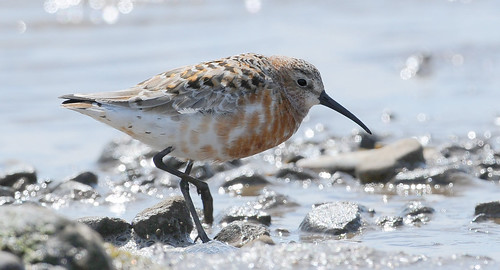It's always good to find a Curlew Sandpiper (CS) and having seen one or two this autumn I was as always fascinated to think of the distance this bird had already flown to reach places like Glasson Dock - which is where I found my first this year - and the further distance it has to travel to reach its wintering grounds.

Time will tell, but there appears to be an influx in the making this autumn with CS's seen around the country and sometimes in decent flocks. These influxes are related to population peaks and/or weather conditions encountered by the birds on migration between the distant parts of the high Arctic tundra of Siberia and wintering grounds mainly in Africa. The CS in spring is invariably seen in small numbers, I personally have never seen one at this time of the year, but the image above is of an adult seen by BR at Marshide 6 June and if this individual was intent on breeding it had a long flight ahead of it.
The adult male CS leaves the breeding grounds immediately after mating - no dedication to your partner there then - and most have commenced migration by mid-July, the female raises the young alone leaving the breeding grounds when they are independent, she then leaves to migrate mainly in early August to begin arriving in Britain by mainly late August with stragglers sometimes into October and even November.
In excess of 2,000 CS have been ringed in the Britain but only a mere fraction of no more than 40 have ever been recovered, but estimated figures of CS passing through the Sivash Gulf, Ukraine in autumn can reach a staggering 140,000. In years of large influxes flocks of up to 500 CS's have been recorded in Britain, the kind of numbers I'd be rubbing my eyes with if I came across them at Glasson Dock. My personal best count was one misty afternoon at Leighton Moss some years ago when I watched 12 come down on to the Allen Pool. Some other numbers I would like to have seen were those of 65 in September 1969, and 30 in September 1972, both recorded at Conder Green.
And finally....
Here's another little gem to be on the look out for in the coming days/weeks. Many thanks to BR/DC for the usual excellent images to brighten up Birds2blog.

A real shame you didnt get out on your usual friday jaunt as there were a good number of migrants around today as exemplified by the number of more 'obvious' Wheatears - one of the better days this year
ReplyDeleteAnother informative post Pete :-) I wont be seeing CS any time soon though !
ReplyDelete